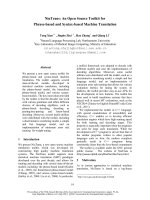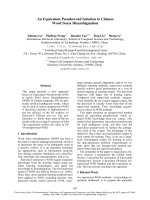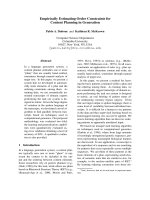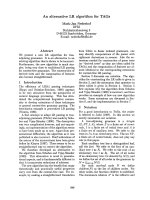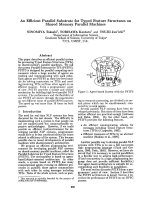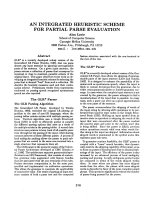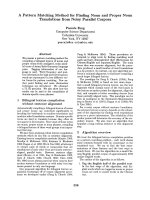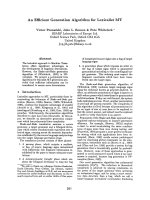Báo cáo khoa học: "An Endogeneous Corpus-Based Method for Structural Noun Phrase Disambiguation" pptx
Bạn đang xem bản rút gọn của tài liệu. Xem và tải ngay bản đầy đủ của tài liệu tại đây (505.33 KB, 6 trang )
An Endogeneous Corpus-Based Method for Structural Noun Phrase
Disambiguation
Didier Bourigault
Centre d'Analyse et de Math6matiques Sociales
(EHESS
-
Paris Sorbonne - CNRS)
and
Electricit6 de France - Direction des Etudes et Recherches
Service Informatique et Math6matiques Appliqu6es
1, avenue du G6n6ral de Gaulle
92141 Clamart Cedex
FRANCE
Abstract
In this paper, we describe a method for structural
noun phrase disambiguation which mainly relies
on the examination of the text corpus under
analysis and doesn't need to integrate any
domain-dependent lexico- or syntactico-semantic
information. This method is implemented in the
Terminology Extraction Sotware LEXTER. We
first explain why the integration of LEXTER in
the LEXTER-K project, which aims at building
a tool for knowledge extraction from large
technical text corpora, requires improving the
quality of the terminolgy extracted by LEXTER.
Then we briefly describe the way LEXTER
works and show what kind of disambiguation it
has to perform when parsing "maximal-length"
noun phrases. We introduce a method of
disambiguation which relies on a very simple
idea : whenever LEXTER has to choose among
several competing noun sub-groups in order to
disambiguate a maximal-length noun phrase, it
checks each of these sub-groups if it occurs
anywhere else in the corpus in a non-ambiguous
situation, and then it makes a choice. The
half-a-million words corpus analysis resulted in
an efficient strategy of disambiguation. The
average rates are :
27 % no disambiguation
70 % correct disambiguation
3 % wrong disambiguation
The LEXTER-K project :
knowledge extraction from large
technical text corpora
LEXTER is a Terminology Extraction Software
(Bourigault, 1992a, 1992b). A corpus of
French-language texts on any (technical) subject is fed
in. LEXTER performs a grammatical analysis of this
corpus and yields a list of noun phrases which are
likely to be terminological units, representing the
concepts of the subject field. This list together with the
corpus it has been extracted from is then passed on to
an expert for validation by the means of a
terminological hypertext web. LEXTER has been
developped in an industrial context, in the Research and
Development Division of Electricit6 de France. It was
previously designed to deal with the problem of
creating or updating thesauri used by an Automatic
Indexing System.
We are integrating LEXTER in a text analysis
tool to aid knowledge acquisition in the framework of
Knowledge-Based System construction. This tool
(LEXTER-K) will propose a structured list of candidate
terms, rather than a flat list, which could be considered
as a first coarse-grained modelisation of the information
conveyed by the texts under analysis.
Structuring of the terminology will be
performed in two ways : on the one hand, by a
structural analysis of the terminological noun phrases
extracted by LEXTER; on the other hand, by an
analysis of the sentences in which the candidate terms
occur. This analysis will focus on the most relevant
terms, determined by a statistical processing based on
the assumption that the most frequent terms are
probably the most relevant.
We plan a two-stage architecture for
LEXTER-K, that is, (1) the extraction of the
terminology of the subject field, by a robust
grammatical analysis (LEXTER), (2) the syntactic
analysis of the sentences by a parser using this
terminology. The syntactic structures of the sentences
in a text, and the syntactic structures of the
terminological units have to be placed on two different
organisational levels. As the terminological unit is a
semantic unit, it should be treated as such on the
syntactic level, as well. Dissociating these two
81
analysis, though one taking advantages of the results
given by the other, will guarantee a better efficiency for
the parser, in particular by limiting the combinatory
explosion of structural ambiguities.
It is well known that Natural Language
systems usually require considerable knowledge
acquisition, especially in building a specifically
oriented field vocabulary in the case of systems which
have to analyse technical texts. We think that this
two-stage analysis (extracting the terminology of the
domain with a robust superficial analysis, and
analysing the texts with a more in-depth parser using
this terminology), may lighten the expensive burden of
hand-coding a specialized language and may lead to
more generic and domain-independant Natural Language
systems.
As long as the terminology extracted during
the first step has not been validated by an expert, as is
now the case, and it directly feeds the syntactic
analyser, this two-stage architecture requires a better
quality of the terminology extracted by LEXTER. This
is the reason why we tried to improve the precision rate
in the detection of the terminological noun phrases by
implementing an efficient strategy for structural noun
phrase disambiguation. This strategy is described in the
following sections.
2
The issue of parsing the
ambiguous "Maximal-Length"
Noun Phrases
In this section, we briefly describe the type of
grammatical analysis performed by LEXTER to extract
likely terminological units and show what kind of
disambiguation LEXTER has to perform.
As we already pointed out, LEXTER has been
achieved in an industrial context; from the beginning of
the project, we had decided to focus upon a strongly
restrictive criterium : applying and testing the system
over a wide range of texts. The texts to be analysed are
unrestricted texts gathered in large corpora. We had then
to choose a fast and well-proved method. Moreover, we
argued that, given the restricted grammatical structures
of complex terminological units, it was not necessary
to go into a complete syntactic analysis of the
sentences to extract the terminology from a corpus
(Bourigault, 1992b).
First, a morphological analyser tags the texts,
using a large lexical database and rules of lexical
disambiguation. LEXTER treats texts in which each
word is tagged with a grammatical category (noun,
verb, adjective, etc.). LEXTER works in two main
phases : (1) splitting and (2) parsing.
(1) At the splitting stage, LEXTER takes
advantage of "negative" knowledge about the form of
terminological units, by identifying those string level
patterns which never go to make up these units and
which can thus be considered as potential
terminological limits. Such patterns are made up by,
say, conjugated verbs, pronouns, conjonctions, certain
strings of preposition + determiner. The splitting
module is thus set up with a base of about 60 rules for
identifying frontier markers, which it uses to split the
texts. The splitting phase produces a series of text
sequences, most often noun phrases. These noun
phrases may well be likely terminological units
themselves, but more often than not, they contain
sub-groups which are also likely units. That is why it
is preferable at the splitting stage to refer to the noun
phrases identified as "maximal-length noun phrases".
Here is an example of a real maximal-length noun
phrase : MESURE DU DEBIT DU VENTILATEUR
D'EXTRACTION AVEC TRAPPE EN POSITION
FERMEE (noun prep det noun prep det noun prep
noun prep noun prep noun adj).
(2) At the parsing stage, LEXTER parses the
maximal-length noun phrases (henceforth MLNP) in
order to generate sub-groups, in addition to the MLNP,
which are likely terminological units by virtue of their
grammatical structure and their position in the MLNP.
The LEXTER parsing module is made up of parsing
rules which indicate which sub-groups to extract from a
MLNP on the basis of grammatical structure.
Some of the MLNP structures are
non-ambiguous : given such a structure it can be stated
with a very high rate of certainty (Bourigault 1992a)
that only one parsing is valid. The corresponding
parsing rules are called non-ambiguous rules. For
example, structure (1) is non-ambiguous, and parsing
rule [a] is a non-ambiguous rule.
(1) noun1 adj prep noun2
parsing
rule
[a]
noun1 adj prep noun2
noun1 adj
example of parse
FUSIBLE THERMIQUE DE FERMETURE
FUSIBLE THERMIQUE
Some of the MLNP structures are ambiguous,
that is, given such a structure it cannot be stated with a
sufficient rate of certainty that only one parsing is
valid. Several sub-structures compete. The
corresponding ambiguous parsing rules generate several
competing sub-groups. For example, when information
about gender or number agreement are not available or
of no help, structure (2) is ambiguous, that is, either
82
the adjective attaches the head
noun1
of the noun
sub-group
noun1 prep noun2,
or it attaches
noun2,
constituting the noun sub-group
(noun2 adj);
the
competing noun sub-groups
(noun1 prep noun2)
and
(noun2 adj)
will be generated by the ambiguous parsing
rule [b]. Structure (3) and parsing rule [c] are other
examples of ambiguous structure and rule.
(2)
noun1 prep noun2 adj
parsing
rule [bl
noun1 prep noun2 adj
# nounl prep noun2
# noun2 adj
example of parse
REGISTRE D' EQUILIBRAGE MANUEL
# REGISTRE D'EQUILIBRAGE
# EQU1LIBRAGE MANUEL
(3)
noun1 prep noun2 prep noun3
parsing
rule [c]
noun1 prep noun2 prep noun3
# noun1 prep noun2
# noun2 prep noun3
example of parse
ALARME DE SYNTHESE DE DEFAUT
# ALARME DE SYNTHESE
# SYNTHESE DE DEFAUT
The issue is how to disambiguate in cases of
MLNP with ambiguous structures, that means,
whenever an ambiguous rule applies, how to choose
among the competing generated sub-groups. The
strategy of disambiguation is described in the next
section.
3
Strategy of disambiguation :
looking at non ambiguous
situations anywhere else in the
corpus
The strategy of disambiguation relies on a very simple
idea, that of looking for non-ambiguous situations
elsewhere in the corpus. Whenever an ambiguous rule
applying to a MLNP with an ambiguous structure
generates competing sub-groups, LEXTER (1) checks
each of them to ascertain if it has been detected in a
non-ambiguous situation (i.e. generated by a
non-ambiguous rule) somewhere else in the corpus, and
(2) chooses among the competing sub-groups using a
set of disambiguation rules.
There is one specific set of disambiguation
rules for each ambiguous structure, which covers all
the possibles situtations, that is, all, some, only one,
none of the competing sub-group non-ambiguously
detected.
3.1 Situations where none of the competing
sub-groups has been non-ambiguously
detected
Given an ambiguous Maximal-Length Noun Phrase, if
none of the competing sub-groups has been detected in
a non-ambiguous situation, LEXTER proposes only
this MLNP, without any sub-group. No
disambiguation is performed. On our half-a-million
words test corpus, the total number of non-ambiguous
MLNPs is 13,591, the total number of ambiguous
MLNPs is 3,230, among which 880 are not
disambiguated. The average rate of no-disambiguation
is 27%. Rates of no-disambiguation for the ten most
frequent ambiguous structures are shown in Table 1.
(1)
noun prep noun adj
noun prep noun prep det noun
noun adj noun
noun prep noun noun
noun prep noun prep noun
noun noun
adj
noun noun noun
noun noun prep noun
noun prep noun prep noun adj
noun prep noun adj adj
(2)
573
331
294
260
241
193
160
82
42
33
(3)
110
91
74
53
55
73
47
27
7
2
(4)
19 %
27 %
25 %
20 %
23 %
38 %
29 %
33 %
17 %
6%
Table 1
Rates of no-disambiguation for the ten most frequent ambiguous structures
(1) ambiguous Maximal-Length Noun Phrase (MLNP) structure
(2) total number of MLNP with this structure on the half-a-million words test corpus
(3) number of cases where none of the competing subgroups has been detected in a non-ambiguous situation
(4) rate of no-disambiguation
83
We are investigating rules that could perform a
correct disambiguation in some of these cases.
Choosing the right sub-group can be done by checking
for each competing sub-group if it has been generated
from the analysis of other ambiguous MLNP. For
example, RE JET D'AIR FROID and CIRCUIT D'AIR
FROID are two ambiguous MLNP extracted from the
test corpus and parsed by parsing rule [lo] above :
REJET D'AIR FROID
# REJET D'AIR
# AIR FROID
CIRCUIT D'AIR FROID
# CIRCUIT D'AIR
# AIR FROID
Since none of the sub-groups RE JET D'AIR
and AIR FROID on the one hand, and CIRCUIT D'AIR
and AIR FROID on the other hand, have been detected
in non-ambiguous situations, the MLNPs RE JET
D'AIR FROID and CIRCUIT D'AIR FROID have not
been disambiguated by LEXTER. But comparing the
parsings of these ambiguous MLNPs (AfR FROID
generated in both cases) can lead to the hypothesis that
extracting AIR FROID is the correct way of
disambiguating them. This hypothesis is reinforced by
the fact that the pattern AIR + adj. is very productive in
the corpus (AIR EXTERIEUR, AIR FRAIS, AIR
NEUF, AIR AMBIANT, AIR RECYCLE, etc.).
Our experiments show that such situations
(sub-groups never non-ambiguously detected but
generated from different ambiguous MLNPs) are very
rare and this explains why we have no specific
treatment for them yet.
nounl prep noun2
detected
nounl prep noun2
not detected
number of occurrences : 141 number of occurrences : 132
noun2 adj noun2 adj noun2 adj
detected number of wrong disamb. : 16 number of wrong disamb. : 1
number of occurrences : 190 number of occurrences : 110
noun2 adj noun1 prep noun2
not detected number of wrong disamb. : 15
Table 2 Set of disambiguation rules for the ambiguous parsing rule [b] :
noun1 prep noun2 adj
->
# nounl prep noun2
# noun,? adj
nounl prep noun2
detected
nounl prep noun2
not detected
number of occurrences : 52 number of occurrences : 81
noun2 prep noun3 noun2 prep noun3 noun2 prep noun3
detected number of wrong disamb. : 2 number of wrong disamb. : 0
number of occurrences : 53 number of occurrences : 55
noun2 prep noun3
not detected
Table 3 Set of disambiguation rules for the ambiguous parsing rule [c] :
nounl prep noun2 prep noun3
->
# nounl prep noun2
# noun2 prep noun3
84
3.2 Situations where at least one competing
sub-group has been non-ambiguously
detected
Given an ambiguous MLNP, systematically keeping
(all) the competing sub-group(s) detected elsewhere in
the corpus in a non-ambiguous situation is not a
satisfying principle of disambiguation. We need more
precise rules of disambiguation.
For example, for each of the parsing rules [b]
and [c], in more than 20 % of the cases on our test
corpus (see top left cells of Table 2 and Table 3), both
competing sub-groups have been non-ambiguously
detected. That means that both sub-groups are attested
valid noun phrases as such. However, only one of them
corresponds to a correct parsing of the MLNP they have
been extracted from. In these cases keeping both
sub-groups would alter the precision rate since one of
them is not grammatically valid. On the contrary,
generating none of them would alter the recall rate. We
chose to build a set of disambiguation rules for each of
the ambiguous parsing rules.
To work out the disambiguation rules, we
adopted an empirical approach based on large-scale
corpus experimentation. For each of the ambiguous
structures, we examined all the different situations of
disambiguation (only one, more than one, all the
competing sub-groups non-ambiguously detected) and
for each of them, we parsed by hand a significative
number of ambiguous noun phrases extracted from a
reference test corpus. Applied to the ambiguous parsing
rules [b] and [c], this approach led us to the following
set of disambiguation rules (see Table 2 and Table 3) :
where both competing sub-groups have been
non-ambiguously detected, we checked that most
often (125 cases/141 for rule [b], 50 cases/52 for rule
[c]) the correct parsing isolates the second
sub-group,noun2 adj for rule [b], noun2 prep noun3
for rule [c] (see the top left cells of Table 2 and
Table 3).
where only the second sub-group has been
non-ambiguously detected, it always corresponds to
the correct parsing and so it is systematically kept
(see the top right cells of Table 2 and Table 3).
parsing rules [b] and [c] differs for the situations
where only the first sub-group (nounl prep noun2
for both rules) has been non-ambiguously detected.
For rule [b], this sub-group is kept since it most
often corresponds to a correct parsing of the MLNP
(175 cases/190, see the bottom left cell of Table 2).
On the contrary, for rule [c], no systematic rule can
be stated since the correct parsing sometimes isolates
this non-ambiguously detected sub-group, but often
isolates the second one (noun2 prep noun3), altough
it appears nowhere else in the corpus in a
non-ambiguous situation (see the bottom left cell of
Table 3). This mainly happens in cases of "elliptical
denominations", that is, a concept is first designated
in a text by a "complete" term (for example,
CIRCUIT D'ASPERSION D'ENCEINTE), and then
is systematically refered to with an "elliptical" term
(for example, CIRCUIT D'ASPERSION).
The results we obtained with such sets of
desambiguation rules (see Table 4) are satisfactory and
show that the strategy described in this paper is
efficient. This is partly due to the fact that
terminological noun phrases are fixed never
disconnected sequences of words with constrained
grammatical structures. Our strategy was not designed
to deal with adjective and prepositional phrase
attachment in unrestricted noun phrases.
rule [b]
noun1 prep noun2 adj
>
# noun1 prep noun2
# noun2 ad, i
rate of no-disambiguation
rate of correct disambiguation
rate of wrong-disambi~uation
rule [c]
noun1 prep noun2 prep noun3
>
# noun1 prep noun2
# noun2 prep noun3
rate of no-disambiguation
rate of correct disambi$uation
rate of wrong-disambiguation
19 %
75 %
6%
45 %
54 %
1%
Table
4 Rates of disambiguation for parsing rules [b]
and[c]
4 Related works
Some of the methodological ideas of LEXTER are
similar to those expressed in (Andreewsky et al., 1977)
for the extraction and disambiguation of lexical
sequences in a method of building lexical semantic
relations dictionaries. More recently a great deal of
work in computational linguistics has been devoted to
ambiguity resolution. Many rule-based approaches have
been proposed which require a huge amount of
hand-coded knowledge. (Jensen and Binot, 1987)
proposes a method to disambiguate prepositional phrase
attachment in English sentences which is similar to
ours in that it aims at eliminating the hand coding of
semantic information by exploiting an already available
source of information. This method differs from ours in
that the source of information is a machine-readable
dictionary, and it uses complex heuristics, which are
different according to the preposition under analysis and
85
it makes use of some semantic relationships signaled
by prepositions.
With regards to the specific problem of
structural noun phrase disambiguation, (Wermter,
1989) describes some experiments on article titles for
scientific and technical domains. These noun phrases
have very similar grammatical structures to those of
our "maximal-length noun phrases". The proposed
approach, based upon the integration of semantic and
syntactic constraints, is quite different from ours since
it requires hand-coding of head nouns with semantic
features.
(Zernik, 1992a, 1992b) describes a method to
distinguish thematic relations (e.g., expressed
concerns), which take on syntactic variations in the
corpus, and sentential relations (e.g., preferred stocks)
that do not. It consists of testing how many times a
given ambiguous relation occurs anywhere else in the
corpus in different syntactic configurations. This
method ("Asking the right questions of the corpus") is
similar to the strategy described in this paper, and we
agree with Zernik's general line of thinking : "In order
for a program to interpret natural language text, it must
train on and exploit word connections in the text under
interpretation (Zernik, 1992a)."
Proceedings of the 2nd symposium of TernuVet,
Avignon, May 1992
[Bourigault, 1992b] Didier Bourigault. Surface
Grammatical Analysis for the Extraction of
Terminological Noun Phrases. In Proceedings of
COLING-92, Nantes, August 1992
[Jensen and Binot, 1987] Karen Jensen and Jean-Louis
Binot. Disambiguating Prepositional Phrase
Attachments by Using On-Line Dictionary
Definition. Computational Linguistics 13 (3-4),
1987
[Wermter, 1989] Stefan Wermter. Integration of
Semantic and Syntactic Constraints for Structural
Noun Phrases Disambiguation. In Proceedings of the
l l th IJCAI, 1989, Detroit
[Zernik, 1992a] Lid Zernik. Shipping Departments vs.
Shipping Pacemakers : Using Thematic Analysis to
Improve Tagging Accuracy. In Proceedings of
AAAI-92, July 1992, San Jose
[Zernik, 1992b] Uri Zernik. Closed Yesterday and
Closed Minds: Asking the Right Questions of the
Corpus To Distinguish Thematic from Sentential
Relations. In Proceedings of COLING-92, August
1992, Nantes
5 Conclusion
We described a method for the structural
disambiguation of complex terminological noun
phrases, which relies on a simple idea : looking for
non-ambiguous situations anywhere else in the corpus.
We call this method Endogeneous since it does not need
to integrate any domain-dependent, lexico- or
syntactico-semantic information. We called it
Corpus-Based since it exploits the experience the
system has acquired after a first reading of the corpus
under analysis. In that sense, our method can be viewed
as a particular implementation of a model of language
Performance (Bod, 1992), and may belong to the family
of Data-Oriented methods in Computational
Linguistics.
References
[Andreewsky et al., 1977] Alexandre Andreewsky,
Christian Fluhr and Fathi Debilli. Computational
Learning of Semantic Lexical Relations for the
Generation and Automatical Analysis of Content.
Information Processing 77, 1977
[Bod, 1992] Rens Bod. A Computational Model of
Language Performance : Data Oriented Parsing. In
Proceedings of COLING-92, Nantes, August 1992
[Bourigault, 1992a] Didier Bourigault. LEXTER, un
Logiciel d'EXtraction de TERminologie. In
86
